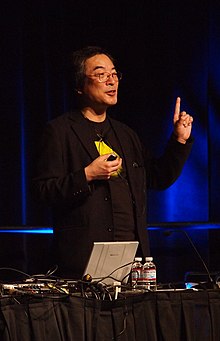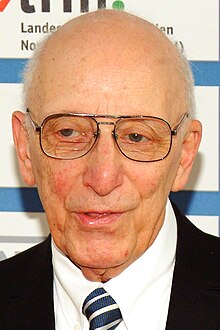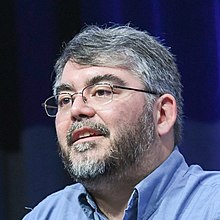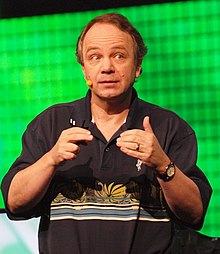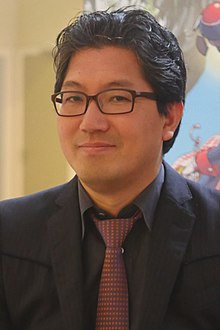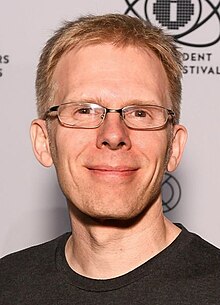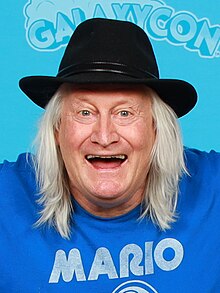Portal:Video games
The Video Games Portal

A video game or computer game is an electronic game that involves interaction with a user interface or input device (such as a joystick, controller, keyboard, or motion sensing device) to generate visual feedback from a display device, most commonly shown in a video format on a television set, computer monitor, flat-panel display or touchscreen on handheld devices, or a virtual reality headset. Most modern video games are audiovisual, with audio complement delivered through speakers or headphones, and sometimes also with other types of sensory feedback (e.g., haptic technology that provides tactile sensations). Some video games also allow microphone and webcam inputs for in-game chatting and livestreaming.
Video games are typically categorized according to their hardware platform, which traditionally includes arcade video games, console games, and computer (PC) games; the latter also encompasses LAN games, online games, and browser games. More recently, the video game industry has expanded onto mobile gaming through mobile devices (such as smartphones and tablet computers), virtual and augmented reality systems, and remote cloud gaming. Video games are also classified into a wide range of genres based on their style of gameplay and target audience. (Full article...)
Featured articles –
Year of the Dragon received positive reviews from critics, who noted the game successfully built on the formula of its predecessors. The game sold more than 3 million copies worldwide. Year of the Dragon was the last Spyro title released for the first PlayStation, and the last developed by Insomniac Games; their next game would be Ratchet & Clank. Year of the Dragon was followed by the multiplatform title Spyro: Enter the Dragonfly, and was later remade as part of the Spyro Reignited Trilogy in 2018. (Full article...)
The team sought to create an immersive world for the player and to compete with the Microsoft Flight Simulator series. Commercially, Flight Unlimited II performed well enough to recoup its development costs. Critics lauded the game's graphics and simulated airspace, and several praised its physics. However, some considered the game to be inferior to Microsoft Flight Simulator 98. Following the completion of Flight Unlimited II, its team split up to develop Flight Unlimited III (1999) and Flight Combat (later Jane's Attack Squadron) simultaneously. Both projects were troubled, and they contributed to the closure of Looking Glass in May 2000. (Full article...)
The gameplay of God of War focuses on combo-based combat, achieved through the player's main weapon—the Blades of Chaos—and a secondary weapon acquired later in the game. It features quick time events that require the player to complete various game controller actions in a timed sequence to defeat stronger enemies and bosses. The player can use up to four magical attacks and a power-enhancing ability as alternative combat options. It also features puzzles and platforming elements.
God of War received critical acclaim, being highly praised for its graphics, sound, story, and gameplay and has been cited as one of the greatest video games ever made. Regarded as one of the best action-adventure games for the platform, God of War won several "Game of the Year" awards. In 2009, entertainment website IGN named God of War the seventh-best PlayStation 2 game of all time. The game had sold over 4.6 million units by June 2012, making it the fourteenth best-selling PlayStation 2 game of all time. The success of the game led to the development of eight more games and expansion into other media. The game and its first sequel, God of War II, were remastered and released in November 2009 as part of the God of War Collection, and in 2012, the remastered version was re-released as part of the God of War Saga, both for the PlayStation 3 and PlayStation Vita. A novelization of the game was published in May 2010, and a film adaptation had been in development for many years but was ultimately canceled. (Full article...)
The game takes place on board a starship in a cyberpunk depiction of 2114. The player assumes the role of a soldier trying to stem the outbreak of a genetic infection that has devastated the ship. Like System Shock, gameplay consists of first-person combat and exploration. It incorporates role-playing elements, in which the player can develop skills and traits, such as hacking and psionic abilities.
System Shock 2 was originally released in August 1999 for Microsoft Windows. The game received critical acclaim but failed to meet commercial sales expectations. Many critics later determined that the game was highly influential in subsequent game design, particularly on first-person shooters, and considered it far ahead of its time. It has been included in several "greatest games of all time" lists. In 2007, Irrational Games released a spiritual successor to the System Shock series, titled BioShock, to critical acclaim and strong sales. (Full article...)
The gameplay is similar to that of the previous installments, and focuses on combo-based combat, achieved through the player's main weapon—the Blades of Athena—and a secondary weapon acquired later in the game. It features quick time events that require the player to complete various game controller actions in a timed sequence to defeat stronger enemies and bosses. Up to three magical attacks and a power-enhancing ability can be used as alternative combat options. Ghost of Sparta also features puzzles and platforming elements. The combat system was updated with 25 percent more gameplay than its PSP predecessor, God of War: Chains of Olympus.
Ghost of Sparta received positive reviews from critics for its story, scope, and graphical illustration, though criticism was given for the general lack of gameplay innovation from its predecessor, Chains of Olympus. Several critics consider it to be the best-looking game on the PSP. Others have compared the overall game to those on the PlayStation 3 (PS3), and some have said that the graphics are better than those of the PlayStation 2 (PS2). Ghost of Sparta received several awards, including "Best Handheld Game", "Best PSP Game", and "PSP Game of Show" at the 2010 Electronic Entertainment Expo (E3), "Best Handheld Game" at the 2010 Spike Video Game Awards, and "Portable Game of the Year" at the 14th Annual Interactive Achievement Awards. By June 2012, it had sold almost 1.2 million copies worldwide, making it the fifteenth best-selling PlayStation Portable game of all time. Together with Chains of Olympus, Ghost of Sparta was remastered and released on September 13, 2011, as part of the God of War: Origins Collection and the remastered version was re-released on August 28, 2012, as part of the God of War Saga, both for the PlayStation 3. (Full article...)
Blizzard announced in March 2006 that the game was put on "indefinite hold" while the company investigated seventh generation video game console possibilities. Subsequent public statements from company personnel had been contradictory about whether production was to be renewed or planned story elements worked into other products. The continued delay of Ghost caused it to be labeled vaporware, and it was ranked fifth in Wired News' annual Vaporware Awards in 2005. In 2014, Blizzard president Mike Morhaime confirmed that Ghost had been canceled.
Unlike its real-time strategy predecessor StarCraft, Ghost was to be a third-person shooter, and intended to give players a closer and more personal view of the StarCraft universe. Following Nova, a Terran psychic espionage operative called a "ghost", the game would have been set four years after the conclusion of StarCraft: Brood War and cover a conspiracy about a secretive military project conducted by Nova's superiors in the imperial Terran Dominion. Very little of the game's storyline has been released; however, in November 2006 after the game's postponement, a novel was published called StarCraft Ghost: Nova, which covers the backstory of the central character. (Full article...)
The original Master System models use both cartridges and a credit card-sized format known as Sega Cards. Accessories include a light gun and 3D glasses that work with specially designed games. The later Master System II redesign removed the card slot, turning it into a strictly cartridge-only system, and is incompatible with the 3D glasses.
The Master System was released in competition with the Nintendo Entertainment System (NES). Its library is smaller and with fewer well-reviewed games than the NES, due in part to Nintendo licensing policies requiring platform exclusivity. Though the Master System had newer, improved hardware, it failed to overturn Nintendo's significant market share advantage in Japan and North America. However, it attained significantly greater success in other markets, including Europe, Brazil, South Korea and Australia. (Full article...)
Did you know... -
- ... that MicroProse was formed to publish Hellcat Ace after Sid Meier boasted that he could design a better video game than Red Baron in a week?
- ... that the developers of the video game Golf Club: Wasteland jokingly announced that they would only sell one copy at a price of $500 million?
- ... that the name of the video game mod series Bomba Patch was inspired by éclairs?
- ... that approximately 85 percent of Manhattan was recreated for the 2008 video game The Incredible Hulk?
- ... that Tetris Holding won an injunction in 2012 to stop sales of a video game clone of their famed Tetris game?
- ... that the web-based video game Moderator Mayhem was based on a card game meant to demonstrate the difficulties of content moderation?
- ... that the robotic enemies in the video game The Incredible Hulk were influenced by Marvel Comics' objection to the Hulk killing humanoid characters?
- ... that the video game JFK Reloaded recreates the assassination of John F. Kennedy from the perspective of the killer?
- ... that the graffiti artists hired for the video game Skitchin' were interviewed at a train station because they were too young to drive?
- ... that a version of the video game Rhino Rumble was not released due to the creators not wanting to add licensed characters?
- ... that the 1999 video game Interplay Sports Baseball Edition 2000 used a public-address announcer while its rivals were switching to two commentators as featured on real MLB game broadcasts?
- ... that Terra Invicta's development company is a group of former volunteer video game modders that decided to release their own game after the success of their mod?
Selected biography –
Selected image -
- April 16, 2024 – 2023–2024 video game industry layoffs
- American video game company Take-Two Interactive lays off 5% of its workforce. (Reuters)
- April 10, 2024 – 2023–2024 video game industry layoffs
- American video game company Epic Games announces that it will lay-off around 870 employees, roughly one-sixth of its workforce, due to slower growth than expected. (CBC via Yahoo! News)
- December 22, 2023 –
- China passes a series of regulations aimed at limiting video game microtransactions. The new rules include banning rewards for logging on for multiple consecutive days and banning rewards for players if they spend money in a game for the first time. (Reuters)
Topics
Categories
Things you can do
In other Wikimedia projects
The following Wikimedia Foundation sister projects provide more on this subject:
-
Commons
Free media repository -
Wikibooks
Free textbooks and manuals -
Wikidata
Free knowledge base -
Wikinews
Free-content news -
Wikiquote
Collection of quotations -
Wikisource
Free-content library -
Wikiversity
Free learning tools -
Wiktionary
Dictionary and thesaurus


